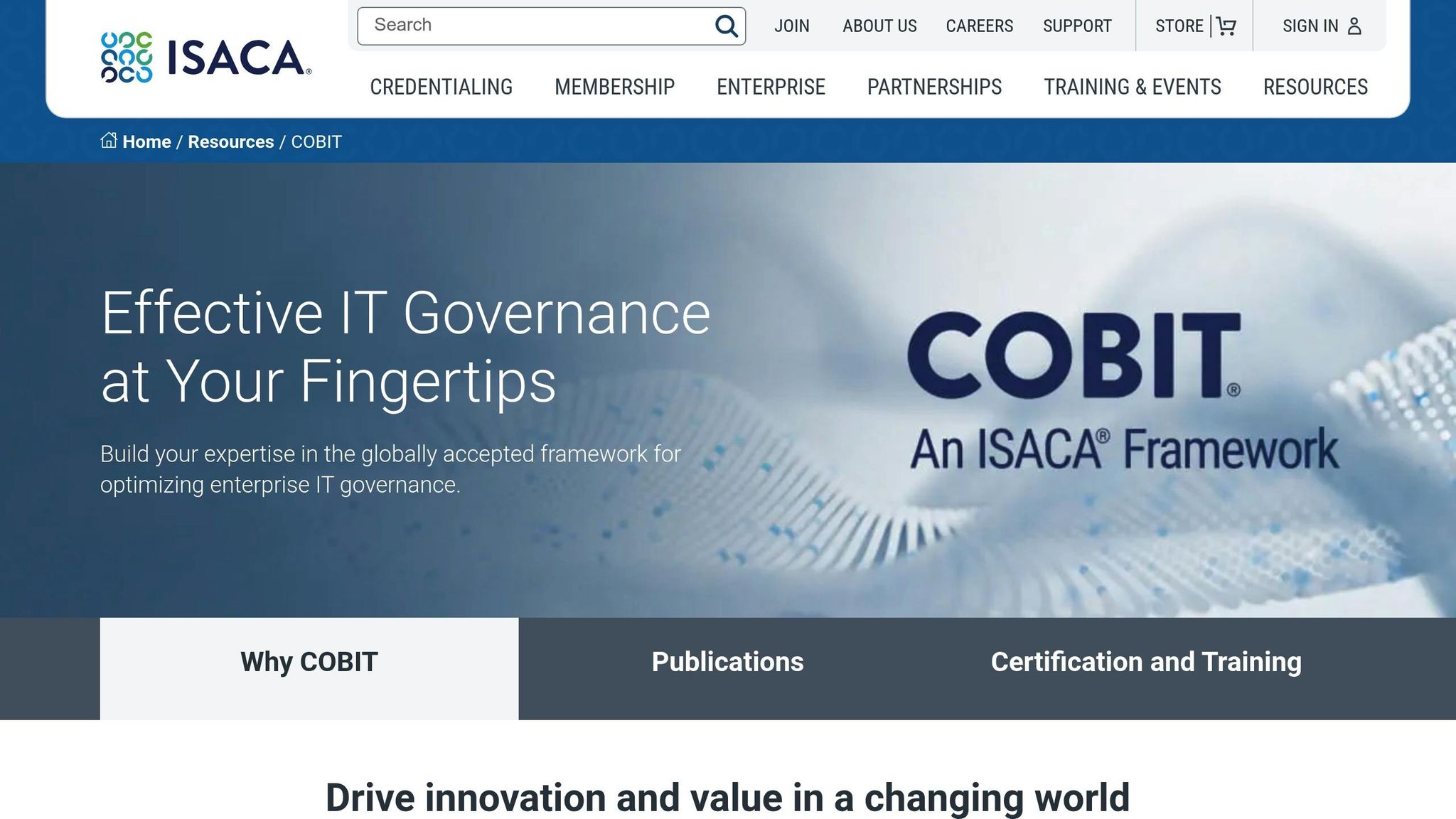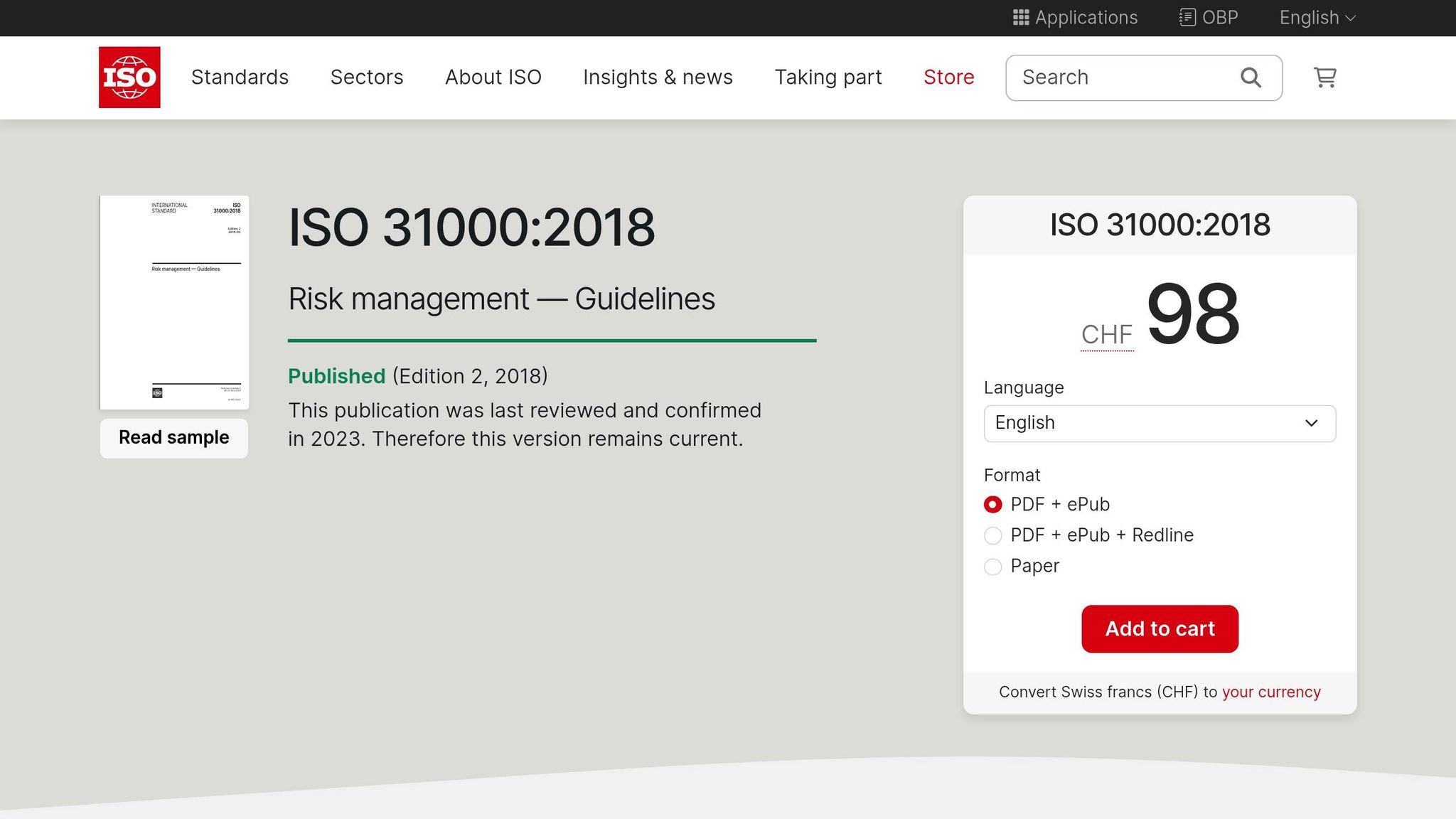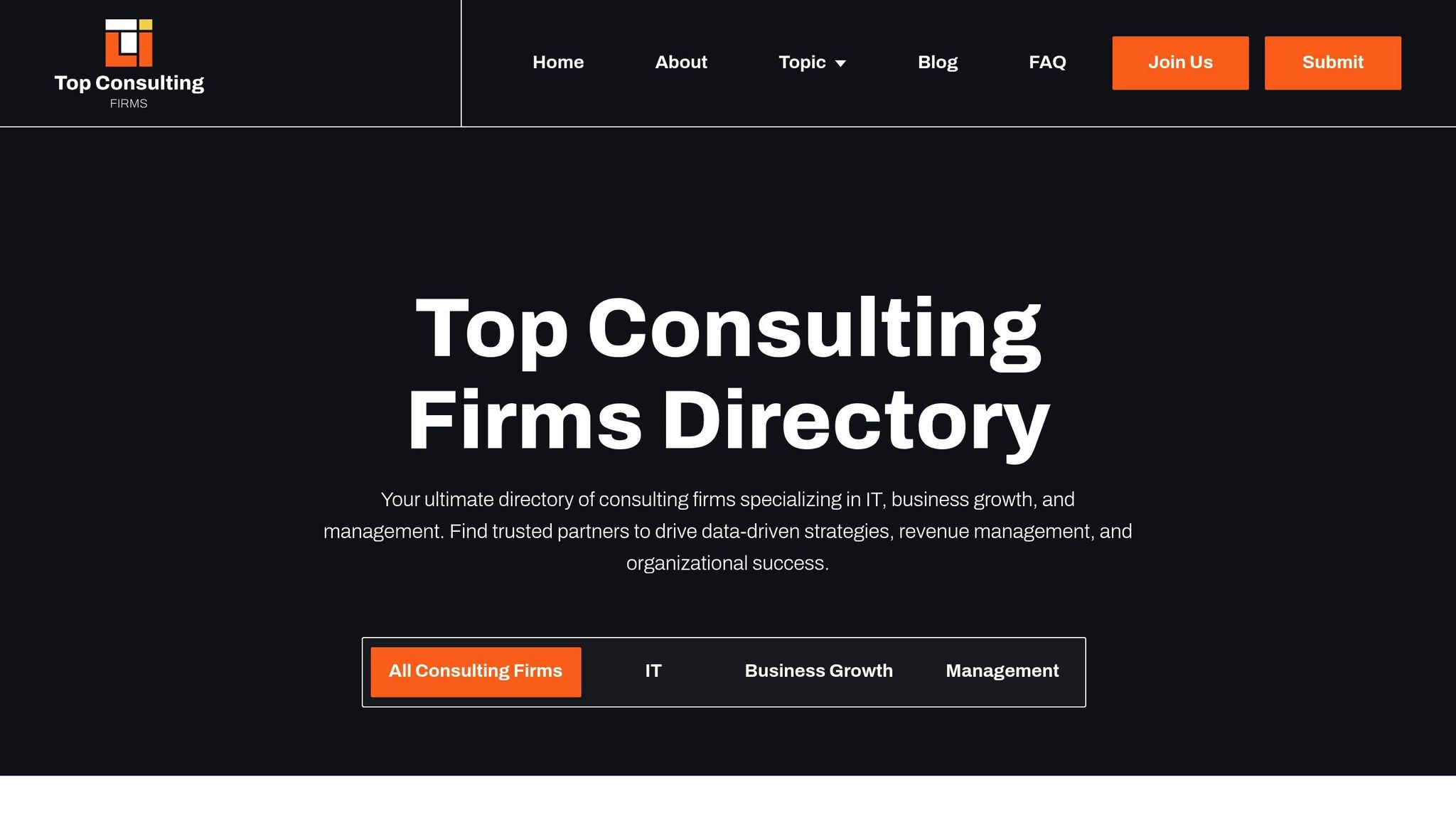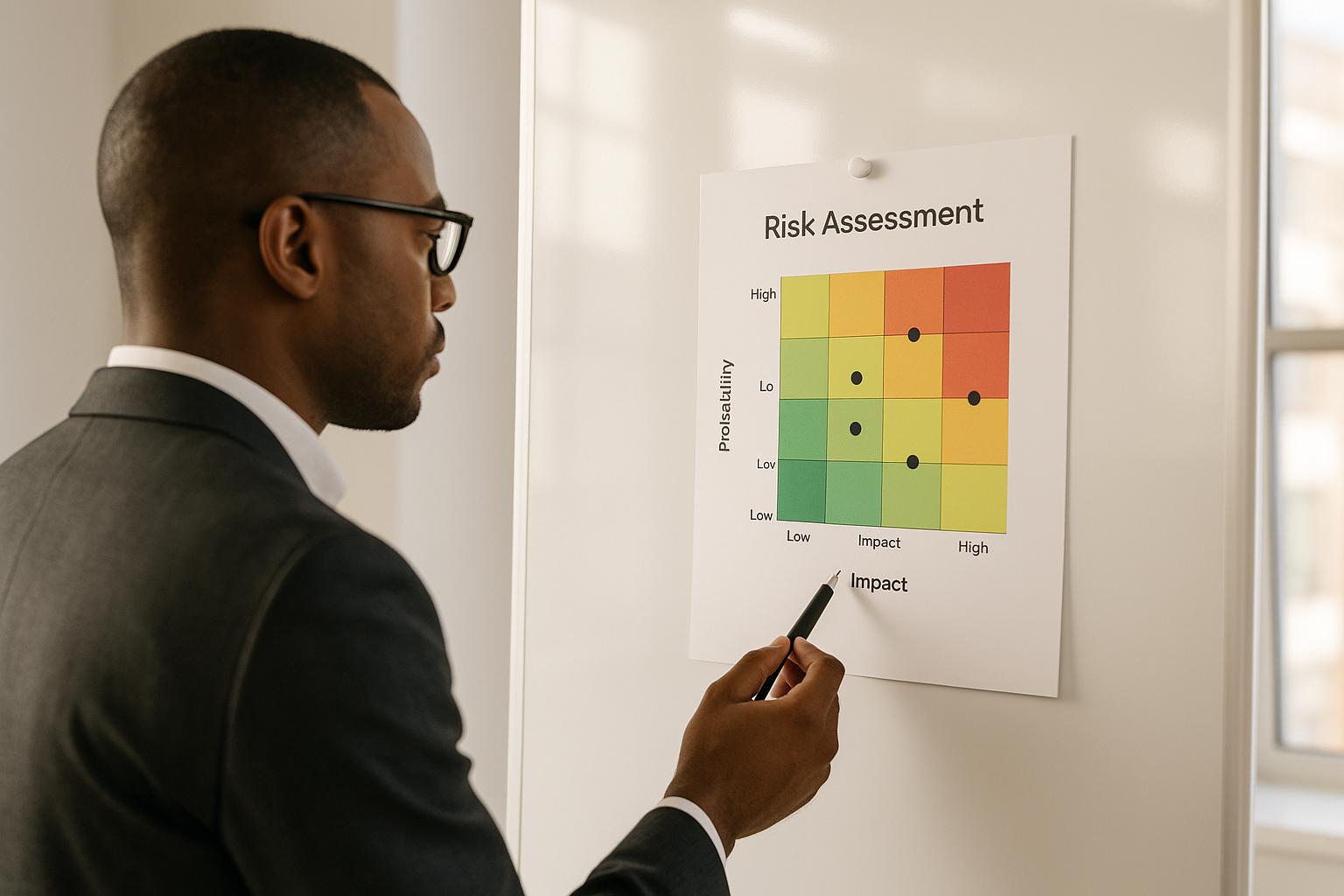Technology risk frameworks are essential for IT consulting firms to help businesses manage risks like cyberattacks, system failures, and compliance issues. These frameworks provide structured approaches to identify vulnerabilities, implement controls, and ensure consistent risk management.
Key Takeaways:
- What are technology risks? Includes cybersecurity breaches, ransomware, cloud issues, and outdated systems.
- Why use frameworks? They help IT consultants assess risks, build client trust, and deliver measurable results.
- Popular frameworks: NIST for cybersecurity, COBIT 2019 for governance, and ISO 31000 for enterprise-wide risk management.
- Implementation steps: Inventory assets, customize frameworks to client needs, and monitor for improvements.
- Overcoming challenges: Address legacy systems, third-party risks, and budget constraints while ensuring stakeholder alignment.
Using frameworks like NIST or COBIT ensures IT firms provide reliable, scalable solutions tailored to clients' industries and regulatory requirements.
Risk Management and NIST Cybersecurity Framework Fundamentals - Lunch & Learn
Key Technology Risk Frameworks
IT consulting firms have access to several established frameworks that help tailor risk management strategies to meet client needs. Each framework brings distinct strengths and methodologies, making it possible to align solutions with specific industries and organizational contexts.
NIST Cybersecurity Framework
The National Institute of Standards and Technology (NIST) Cybersecurity Framework is widely used in the United States, especially for managing cybersecurity risks. While it was initially designed for critical infrastructure, its practical structure has made it applicable across various industries.
The framework organizes cybersecurity efforts into five core functions: Identify, Protect, Detect, Respond, and Recover. It also introduces four implementation tiers, which guide organizations from basic to more advanced risk management practices.
One of NIST's key benefits is its scalability. It doesn’t mandate specific technologies, giving IT consultants the flexibility to tailor strategies based on factors like a client’s size, industry, and risk tolerance. For instance, a small manufacturing company might focus on basic security measures, while a large financial institution could adopt a more comprehensive risk management plan.
Consultants can use NIST's implementation tiers to assess a client’s current capabilities and develop a step-by-step improvement plan that aligns with their business goals and resources. Additionally, NIST's flexibility can be complemented by COBIT 2019, which brings a governance-focused perspective to risk management.
COBIT 2019

COBIT 2019 shifts the focus to IT governance and aligning technology investments with overall business goals. This framework offers 40 governance and management objectives, using key performance indicators (KPIs) and key goal indicators (KGIs) to evaluate the effectiveness of risk management efforts.
For IT consultants working closely with executives and board members, COBIT provides a way to translate technical risks into strategic business concerns. Its performance management system helps organizations measure how well their risk management initiatives support broader business objectives.
The framework also includes a "design factors" approach, which allows consultants to customize their recommendations based on an organization’s strategy, risk profile, compliance needs, and IT challenges. COBIT emphasizes that successful risk management requires a balance between people, processes, and technology. This holistic view is particularly useful for addressing organizational culture and managing change effectively. While COBIT focuses on governance, broader standards like ISO 31000 address enterprise-wide risk concerns.
ISO 31000 and Other Frameworks

ISO 31000 offers a comprehensive approach to risk management that goes beyond technology to address enterprise-wide challenges. It provides a structured process that includes defining context, assessing risks (through identification, analysis, and evaluation), treating risks, and maintaining ongoing monitoring and communication.
This framework’s emphasis on stakeholder engagement makes it especially useful when technology risks intersect with operational, financial, or strategic issues. For example, it ensures that all relevant parties are involved in discussions about risk, which can lead to better decision-making.
Other frameworks, such as FAIR and OCTAVE, offer specialized approaches. FAIR provides a quantitative method for translating technical vulnerabilities into financial risks, making it ideal for organizations that need data-driven insights. OCTAVE, on the other hand, focuses on identifying key information assets, associated threats, and potential impacts, making it well-suited for asset-based risk assessments.
Each framework has its strengths: ISO 31000 is ideal for organizations seeking a unified risk management strategy, FAIR is valuable for environments that require financial quantification of risks, and OCTAVE works well for those prioritizing asset-focused risk planning. By understanding these frameworks, IT consultants can select and adapt the best approach for each client’s unique needs and objectives.
How to Implement Technology Risk Frameworks
Turning a technology risk framework from a concept into a practical tool requires a well-structured approach. IT consulting firms need to strike a balance between being thorough and efficient, ensuring that the framework aligns with the client’s unique environment and regulatory demands.
Cataloging Technology Assets
A solid risk management strategy starts with a detailed inventory of all technology assets - hardware, software, data flows, system dependencies, and their importance to business operations.
The inventory should include both physical and digital resources. Physical assets might be servers, routers, mobile devices, or IoT sensors. Digital assets could range from databases and software applications to cloud services and intellectual property stored electronically. It’s also important to document the security status and dependencies of each asset.
Prioritizing assets based on their business impact is key. For example, a customer-facing e-commerce platform would typically take precedence over internal tools like a document management system. This prioritization ensures that mitigation efforts are focused where they matter most.
Mapping system dependencies is another crucial step. This process can reveal vulnerabilities, like legacy systems that play a critical role or third-party services that could lead to cascading failures. By understanding these connections, consultants can suggest redundancy measures and contingency plans to minimize risks.
Additionally, compliance requirements for each asset must be documented. Whether it’s HIPAA for healthcare data, PCI DSS for payment systems, or SOX for financial reporting, understanding these obligations ensures the framework is built to meet all necessary regulations from the start.
With a clear and organized asset inventory, it becomes easier to design a risk framework tailored to the client’s specific needs.
Customizing Frameworks for Clients
Once the asset inventory and risk factors are clear, the next step is to adapt the framework to fit the client’s risks, industry standards, and organizational setup. This process starts with understanding the client’s risk tolerance, business goals, and operational limitations.
Different industries have different needs. Healthcare organizations might require a heavy focus on patient data security and medical devices, while financial firms may prioritize fraud prevention and regulatory reporting. Manufacturing companies often need frameworks that address operational technology and supply chain risks.
Regulatory compliance is another major factor. Industries with strict regulations, like banking or healthcare, need frameworks that align with specific rules. For instance, a bank using COBIT 2019 would need to integrate Basel III principles and ensure governance objectives meet financial regulatory standards.
The framework should also suit the organization’s size and maturity. A startup with a small IT footprint won’t need the same level of complexity as a large enterprise with legacy systems. The goal is to create a framework that can grow with the organization, allowing it to enhance its risk management practices over time without requiring a complete overhaul.
Cultural factors also play a role. Some organizations prefer detailed, step-by-step guidelines, while others lean toward flexible frameworks that allow for interpretation. Understanding these preferences ensures the framework is well-received and effectively adopted.
Finally, resource constraints must be considered. Smaller businesses with limited budgets or security staff may need frameworks that emphasize cost-effective solutions and automation to maximize risk reduction with minimal effort.
Monitoring and Continuous Improvement
Risk frameworks are not static - they need regular updates to stay effective in the face of evolving threats and business changes.
From the start, set measurable performance metrics to evaluate the framework’s effectiveness. Metrics like incident response times, vulnerability patch rates, compliance results, and business impact assessments can highlight strengths and pinpoint areas for improvement.
Staying on top of the threat landscape is crucial. This means keeping an eye on industry-specific risks, monitoring threat intelligence feeds, and participating in information-sharing networks. When new threats emerge, the framework should be reviewed and updated to ensure it provides adequate coverage.
Integrating risk management into business change processes is another important step. Whether it’s a new system rollout, a change in business operations, or a company restructuring, these shifts can introduce risks that should be assessed and managed within the framework.
Periodic reviews - annually or bi-annually, depending on the organization’s risk profile - help ensure the framework stays relevant. These reviews should involve a diverse group of stakeholders to get a comprehensive view of its effectiveness and alignment with business objectives.
As technology evolves, frameworks need to adapt. The rise of cloud computing, digital transformation, artificial intelligence, and blockchain often introduces new risks that may require adjustments to existing controls.
Finally, lessons from incidents should feed back into the framework. Each security breach or operational failure should be analyzed to identify gaps and refine the framework, creating a continuous improvement loop that strengthens risk management over time.
Best Practices in Technology Risk Management
Effective technology risk management isn't just about picking the right framework - it's about putting it into action strategically, securing stakeholder support, and tackling challenges head-on. IT consulting firms that excel in these areas can craft solutions that not only safeguard clients but also drive business success.
Engaging Stakeholders
Getting buy-in across the organization can make or break a risk management framework. Collaboration across departments ensures that risk management becomes a core part of the company’s operations rather than a mere compliance exercise.
Key players include:
- Business leaders: Focused on protecting revenue and aligning risk management with strategic goals.
- IT teams: Need clear technical guidance and a roadmap for implementation.
- Compliance officers: Ensure the framework aligns with regulatory requirements.
- Finance departments: Value measurable returns on investment and cost efficiency.
Tailoring communication to each audience is essential. Executives, for example, care about the business impact and operational efficiency, not the nitty-gritty technical details. On the other hand, IT teams need in-depth instructions and integration plans.
Regular risk committee meetings can keep everyone aligned and accountable. These sessions should include representatives from all major stakeholder groups and focus on actionable steps rather than theoretical discussions.
Training programs are another cornerstone of stakeholder engagement. These should be tailored to the specific needs of each group:
- General employees benefit from security awareness training.
- IT staff need in-depth technical training.
- Leadership teams require focused briefings on strategic risks and high-level frameworks.
When it comes to reporting, one size doesn’t fit all. IT teams might need detailed vulnerability assessments, while executives benefit more from dashboards summarizing key risk indicators. By customizing data presentation, you ensure everyone gets what they need to act effectively.
Once stakeholders are aligned, the focus shifts to overcoming common challenges in implementation.
Addressing Common Challenges
Even the best-designed frameworks can run into obstacles during deployment. Identifying these potential roadblocks early and preparing solutions can prevent small issues from snowballing into major setbacks.
Legacy systems often present integration challenges. In these cases, compensating controls - like network segmentation, enhanced monitoring, or stricter access management - can help mitigate risks while modernization efforts are underway.
Unauthorized use of cloud services is another frequent issue. Employees may adopt tools without IT’s approval, creating security gaps. To address this, establish clear processes for evaluating and approving new technologies and make the approval process efficient to discourage workarounds.
Third-party risks are increasingly complex as companies rely more on external vendors and cloud providers. Vendor assessments should match the importance and risk level of the relationship. For example, a critical cloud provider requires thorough due diligence, while a low-risk tool may only need basic verification. Standardized templates can streamline these assessments while maintaining thoroughness.
Budget constraints are a reality for many organizations. Start by focusing on high-impact, low-cost measures like patching, access reviews, and employee training. These steps can significantly reduce risk without requiring large investments.
Resistance to change is another common hurdle. Involve key users during the design phase, clearly communicate the benefits, and celebrate early successes. When employees see how risk management prevents problems instead of just adding bureaucracy, they’re more likely to embrace it.
To show the value of the framework, establish baseline metrics such as incident response times, compliance audit outcomes, or system uptime. Highlighting business-focused results rather than purely technical metrics can make the benefits clearer to all stakeholders.
Regulatory requirements can become overwhelming, especially for organizations operating in multiple regions or industries. A compliance matrix that maps framework controls to specific regulations can help ensure nothing is overlooked while avoiding unnecessary duplication.
Finally, the rapid pace of technology introduces new risks that existing frameworks may not fully address. Stay informed by engaging with industry groups, monitoring threat intelligence, and working with technology vendors. Build flexibility into your framework so it can adapt to new challenges without disrupting existing processes.
Clear communication between technical and business teams is critical. Misalignment often leads to friction, so establish regular communication channels and clear escalation paths. When both sides understand each other’s priorities and constraints, collaboration improves, and implementation runs more smoothly.
sbb-itb-97f6a47
Using External Resources for Risk Framework Implementation
Implementing technology risk frameworks often demands a level of expertise that many organizations simply don’t have in-house. The growing complexity of cybersecurity threats, shifting regulatory landscapes, and the technical challenges of integration can overwhelm even well-equipped internal teams. This is where external consulting becomes a critical piece of the puzzle.
The consulting market is vast, offering a wide range of expertise in technology risk management. Tapping into this external knowledge can provide the tailored support organizations need to implement effective risk frameworks.
However, finding the right consulting partner is no small task. It’s essential to choose a firm with a solid track record in your specific industry, regulatory environment, and technology stack. Picking the wrong partner can lead to wasted resources, project delays, and gaps in risk coverage.
How the Top Consulting Firms Directory Can Help

When internal capabilities fall short, external expertise can make all the difference. The Top Consulting Firms Directory is a curated resource designed to connect organizations with expert consulting services in technology risk management. Instead of spending weeks researching potential partners, businesses can access a vetted list of firms specializing in areas like cybersecurity, IT infrastructure, digital transformation, and risk management.
The directory features firms with proven experience in implementing frameworks such as NIST, COBIT, and ISO 31000. These firms bring expertise in areas like cloud services, data analytics, and cybersecurity, making them well-equipped to handle the diverse needs of organizations across industries and sizes.
One of the directory's standout features is its emphasis on quality over quantity. By curating firms based on their expertise, track record, and specialization, it simplifies the vendor selection process. This not only saves valuable time but also increases the likelihood of finding a partner that truly aligns with your needs. For IT consulting firms, the directory can be particularly helpful when additional expertise is needed - such as pairing a team skilled in software development with a partner experienced in regulatory compliance or industry-specific challenges.
The directory also provides clarity on the range of consulting services available, from initial risk assessments and framework selection to ongoing monitoring and continuous improvement programs. This makes it easier for organizations to identify firms that align with their specific risk management goals.
Budget constraints often make external guidance a practical solution. Hiring consultants allows organizations to access senior-level expertise on a project basis without committing to the long-term costs of full-time staff. The directory helps businesses find firms that balance quality with budget considerations.
Another advantage is the directory's categorization by service areas. This enables targeted searches, making it simple to find firms with experience in cloud migration security, third-party risk management, or regulatory compliance. For companies operating globally or navigating international regulations, the directory can point to partners with the necessary global capabilities.
Finally, the directory’s vetting process adds an extra layer of confidence. By featuring firms that have been evaluated for their expertise, track record, and professional standards, it minimizes the risk of engaging with inexperienced or unreliable partners. This ensures that organizations can focus on achieving their risk management goals with trusted support.
Conclusion
Technology risk frameworks are now a cornerstone for IT consulting firms navigating today’s fast-evolving digital environment. Technology risks touch nearly every part of an organization - its assets, people, processes, systems, and even vendor relationships. This makes having a structured approach to identify and manage these risks more important than ever.
These frameworks provide a comprehensive, organization-wide perspective, breaking down silos to reduce gaps and overlaps. By systematically identifying, assessing, and addressing IT-related risks, they enhance IT operations, strengthen cybersecurity, and improve overall risk management.
For IT consulting firms, these frameworks are more than just tools - they’re enablers. They empower consultants to help clients get the most out of their technology investments while keeping potential threats in check.
As highlighted earlier, many organizations face challenges that surpass their in-house capabilities, especially when dealing with complex threats or meeting regulatory requirements. This is where external expertise becomes critical. Resources like the Top Consulting Firms Directory make it easier to find skilled IT consulting partners. By listing firms experienced in frameworks like NIST, COBIT, and ISO 31000, the directory simplifies the selection process and helps reduce risks tied to vendor choices.
When structured risk frameworks are paired with expert implementation, they form a solid foundation for managing technology risks effectively. As digital transformation accelerates and cyber threats grow more sophisticated, IT consulting firms that excel in applying these frameworks - whether through internal teams or strategic partnerships - will be best equipped to deliver exceptional results for their clients.
Managing technology risks isn’t optional anymore - it’s a critical business need that demands both the right tools and the right expertise.
FAQs
How can IT consulting firms adapt technology risk frameworks to meet the unique needs of various industries and organizations?
IT consulting firms can fine-tune technology risk frameworks by aligning them with the unique risks, operational needs, and compliance standards of each industry or organization. This often means working with well-established frameworks like NIST, COBIT, or ISO 31000 and adjusting their key elements - such as risk assessments and control mechanisms - to fit the specific challenges faced by the business.
This process might involve setting industry-specific risk tolerance thresholds, incorporating applicable regulations, and blending the framework seamlessly with the organization’s existing workflows. These tailored adjustments help ensure the framework not only addresses vulnerabilities effectively but also supports compliance efforts and strengthens the company’s overall approach to managing risks.
What challenges do IT consulting firms face when implementing technology risk frameworks, and how can they address them?
IT consulting firms often grapple with hurdles such as tight budgets, staffing shortages, the ever-changing nature of risks, and gaps in expertise or governance when trying to implement technology risk frameworks. These challenges can make it tough to keep up with threats and maintain compliance.
To overcome these obstacles, firms should focus on proactive risk management, allocate resources to employee training, and set up well-defined governance protocols. These steps not only strengthen resilience but also ensure the framework stays effective as risks continue to shift and grow.
What are the key differences between NIST, COBIT 2019, and ISO 31000 for managing technology risks, and how do you decide which one to use?
NIST, COBIT 2019, and ISO 31000: Comparing Approaches to Risk Management
When it comes to managing technology risks, NIST, COBIT 2019, and ISO 31000 each bring something different to the table, catering to various organizational priorities.
- NIST focuses heavily on cybersecurity. It provides detailed technical controls aimed at safeguarding information systems. This makes it a go-to choice for organizations that put a premium on securing their data and systems.
- COBIT 2019 zeroes in on IT governance. It helps businesses ensure their IT operations align seamlessly with overall strategic goals. If your organization needs a structured approach to IT governance, this framework fits the bill.
- ISO 31000 takes a broader, principles-based approach to risk management. It’s designed to be flexible, making it suitable for enterprise-wide risk management across different industries.
How to choose? Go with NIST for tackling specific cybersecurity issues, COBIT 2019 when aligning IT with business objectives, and ISO 31000 if you’re looking for an adaptable framework that can handle risks across the board.


